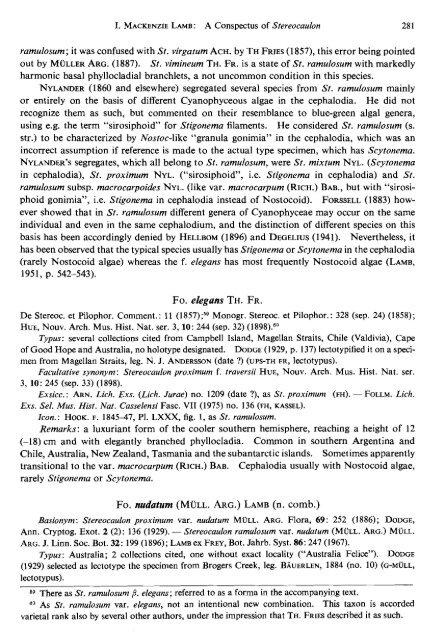A CONSPECTUS OF THE LICHEN GENUS STEREOCAULON ...
A CONSPECTUS OF THE LICHEN GENUS STEREOCAULON ...
A CONSPECTUS OF THE LICHEN GENUS STEREOCAULON ...
You also want an ePaper? Increase the reach of your titles
YUMPU automatically turns print PDFs into web optimized ePapers that Google loves.
I. MACKENZIE LAMB: A Conspectus of Stereocaulon 28 1<br />
ramulosum; it was confused with St. virgatum ACH. by TH FRIES (1857), this error being pointed<br />
out by M~~LLER ARG. (1887). St. vimineum TH. FR. is a state of St. ramulosum with markedly<br />
harmonic basal phyllocladial branchlets, a not uncommon condition in this species.<br />
NYLANDER (1860 and elsewhere) segregated several species from St. ramulosum mainly<br />
or entirely on the basis of different Cyanophyceous algae in the cephalodia. He did not<br />
recognize them as such, but commented on their resemblance to blue-green algal genera,<br />
using e.g. the term "sirosiphoid" for Stigonema filaments. He considered St. ramulosum (s.<br />
str.) to be characterized by Nostoc-like "granula gonimia" in the cephalodia, which was an<br />
incorrect assumption if reference is made to the actual type specimen, which has Scytonema.<br />
NYLANDER'S segregates, which all belong to St. ramulosum, were St. mixtum NYL. (Scytonema<br />
in cephalodia), St. proximum NYL. ('Lsir~~iphoid'', i.e. Stigonema in cephalodia) and St.<br />
ramulosum subsp. macrocarpoides NYL. (like var. macrocarpum (RICH.) BAB., but with "sirosiphoid<br />
gonimia", i.e. Stigonema in cephalodia instead of Nostocoid). FORSELL (1883) however<br />
showed that in St. ramulosum different genera of Cyanophyceae may occur on the same<br />
individual and even in the same cephalodium, and the distinction of different species on this<br />
basis has been accordingly denied by HELLBOM (1896) and DEGELIUS (1941). Nevertheless, it<br />
has been observed that the typical species usually has Stigonema or Scytonema in the cephalodia<br />
(rarely Nostocoid algae) whereas the f. elegans has most frequently Nostocoid algae (LAMB,<br />
1951, p. 542-543).<br />
Fo. elegans TH. FR.<br />
De Stereoc. et Pilophor. Comment. : 11 (1857);n0 Monogr. Stereoc. et Pilophor. : 328 (sep. 24) (1858);<br />
HUE, NOUV. Arch. Mus. Hist. Nat. ser. 3, 10: 244 (sep. 32) (1898).80<br />
Typus: several collections cited from Campbell Island, Magellan Straits, Chile (Valdivia), Cape<br />
of Good Hope and Australia, no holotype designated. DODGE (1929, p. 137) lectotypified it on a specimen<br />
from Magellan Straits, leg. N. J. ANDERSON (date ?) (UPS-TH FR, lectotypus).<br />
Facultative synonym: Stereocaulon proximum f. traversii HUE, Nouv. Arch. Mus. Hist. Nat. ser.<br />
3, 10: 245 (sep. 33) (1898).<br />
Exsicc. : ARN. Lich. Exs. (Lich. Jurae) no. 1209 (date ?), as St. proximum (FH). - FOLLM. Lich.<br />
Exs. Sel. Mus. Hist. Nat. Casselensi Fasc. VII (1975) no. 136 (FH, KASSEL).<br />
Icon. : HOOK. F. 184547, PI. LXXX, fig. 1, as St. ramulosum.<br />
Remarks: a luxuriant form of the cooler southern hemisphere, reaching a height of 12<br />
(-18) cm and with elegantly branched phyllocladia. Common in southern Argentina and<br />
Chile, Australia, New Zealand, Tasmania and the subantarctic islands. Sometimes apparently<br />
transitional to the var. macrocarpum (RICH.) BAB. Cephalodia usually with Nostocoid algae,<br />
rarely Stigonema or Scytonema.<br />
Fo. nudatum (MULL. ARG.) LAMB (n. comb.)<br />
Basionym: Stereocaulon proximum var. nudatum MULL. ARG. Flora, 69: 252 (1886); DODGE,<br />
Ann. Cryptog. Exot. 2 (2): 136 (1929). - Stereocaulon ramulosum var. nudatum (MULL. ARG.) MULL.<br />
ARG. J. Linn. Soc. Bot. 32: 199 (1896); LAMB ex FREY, Bot. Jahrb. Syst. 86: 247 (1967).<br />
Typus: Australia; 2 collections cited, one without exact locality ("Australia Felice"). DODGE<br />
(1929) selected as lectotype the specimen from Brogers Creek, leg. BAUERLEN, 1884 (no. 10) (G-MULL,<br />
lectotypus).<br />
There as St. ramulosum ,5'. elegans; referred to as a forma in the accompanying text.<br />
Bo AS St. ramulosum var. elegans, not an intentional new combination. This taxon is accorded<br />
varietal rank also by several other authors, under the impression that TH. FRIES described it as such.

















